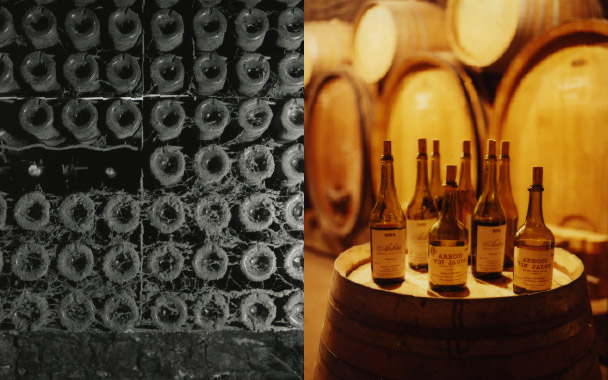One of the five greatest white wines of the world (according to no less than Curnonsky, the “prince of gastronomes,” at any rate) isn’t even legal in the United States. Which isn’t to say it can’t be found. Recently, for instance, in the back room of Hearth, a small group of wine geeks assembled for the rare chance to taste Château-Chalon.
The wine comes from a miniscule appellation in France’s Jura region devoted exclusively to vin jaune, a white wine from the local Savagnin grape that turns deep yellow as it ages for years in wooden barrels that are filled only partway. The oxygen that gets into the barrels would turn most wines to vinegar, but vin jaune develops a thin, protective blanket of yeasts (voile, in local wine parlance) that rests on top of the wine, partly protecting it and partly imparting a freakishly delicious nutty, salty character.
That’s the legal part. The illegal part is the clavelin, the short, squat bottle traditional to the area that holds only 620 ml. In the U.S., however, the ATF doesn’t recognize that size bottle (only standard bottle sizes, like 750 ml and 375 ml, are recognized)—making vin jaune theoretically impossible to import.
Nonetheless, when Jean Berthet-Bondet, who runs a small winery in Château-Chalon, recently came to New York City with his wife, Chantal, Hearth’s Paul Grieco shanghaied him and a few bottles of his wines for a late-night tasting. “Of all the wines I have not tried in my wine career, Château-Chalon remains at the top, along with any Bordeaux from the Jefferson vintage of 1783” was Grieco’s excuse for arranging the last-minute event.
Not all of Berthet-Bondet’s wines are made in an oxidized style; it turns out that he also makes a bright, yeasty, mineral-laden Chardonnay and a sharp, light red from a blend of the local Trousseau, Poulsard, and Pinot Noir, both of which are entirely legal and available here. He also makes “Tradition,” a blend of Chardonnay and Savagnin that is aged for just two years under a voile and tastes like salted caramel; this mini vin jaune is, he says, what he and Chantal drink at home every week, “especially on Sunday, with smoked fish, or white meat in a cream sauce.” Pressed for more details, he says, “It’s great with Comté. And frogs. We have a lot of frogs in the Jura.”
The Château-Chalon is only for special occasions, he says. There simply isn’t much of it—only 136 acres (about the size of a smallish dairy farm) are zoned for its production. And it takes ages for the wine to realize its full potential. The 2000 he pours is just beginning to deepen into a caramel richness; it’s more at a salted-peanut stage, a little like an adolescent well on her way to self-realization but not quite there. The 1989, however, tastes like a mound of morels sautéed in an embarrassment of browned butter, satin-textured and seamless. “It probably won’t change much now,” he says, so there’s no great gain to saving it longer—but it also won’t lose what it has for a long time to come; Berthet-Bondet says he knows people who tasted a wine from 1774 that was reportedly still good. What’s more, since the wine is already fairly oxidized, it’s not afraid of a little more air: It will stay vibrant for up to a month after it’s opened, provided it is recorked and kept in the fridge.
If only it were easier to find. Somebody petition the ATF, will you?

